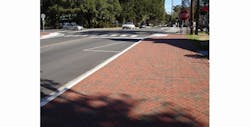Residents of Bluffton, S.C., have a secret—a time capsule of a small southern coastal village. Plantation owners who wanted a summer’s respite from the heat on Low Country cotton and rice plantations built the first homes there in the early 1800s.
Today, you can walk beneath a canopy of live oak trees in the 1-sq-mile section of Old Town on sidewalks adjoining streets that were laid out more than a century ago. Here, a stone’s throw from Hilton Head, the breezes blow inland off the May River, where some of the best oysters in the world are harvested.
When the time came to renovate Old Town, the goals were to come up with a design that would complement the architecture, but at the same time protect the trees and maintain the water quality in the river.
Permeable pavement for the sidewalks—especially in areas surrounding the old-growth trees—was specified to keep tree roots watered and to help cut down on water pollution. A Rumbled StormPave paver from Pine Hall Brick Co. was chosen.
Paige Camp, who serves on Bluffton’s Historic Preservation Commission, says that the pavers, which are roughed up on purpose during the manufacturing process, look like they have been there all along.
“Since the rest of the town is a little bit worn at the edges, we would be comfortable with it,” Camp said. “Hopefully we are preserving the look and the feel of this quirky town.”
Karen Jarrett, the transportation project manager for the town, says the project was intended to slow down traffic, increase pedestrian access and improve drainage.
Originally other materials were considered, but “we just thought the clay was better and more in keeping with the look and feel and characteristics that we have,” said Camp.
The pavers look similar to conventional clay brick pavers, although the voids—the spaces between the pavers—are slightly wider, at ¼ in. And instead of sand, the pavers have small stones swept into the voids.
The secret is in what is underneath. Instead of crushed gravel and sand, which is used in conventional clay brick paving systems, a series of open-graded aggregates without fine particles are used. The aggregates allow the water to flow as good bacteria build around the rock over time and aid in reducing some pollutants.
Permeable pavement systems not only help the environment, but also can open up more land for development. In some commercial installations, a traditional retention pond, expensive ditching, storm water sewer and redirection of surface water can be reduced or eliminated. In addition, use of a permeable paver system can help developers obtain a number of the U.S. Green Building Council’s Leadership in Energy and Environmental Design credits.
That is certainly something to be considered beforehand, in the planning stages. After the pavers are installed, the townspeople of Bluffton say that the finished result is beautiful, durable and green.
“It’s beautiful now that it is in,” said Jarrett. “It looks very nice and we haven’t had any complaints so far. And we have had quite a few compliments.”
Walt Steele is paver business manager for Pine Hall Brick Co. Steele can be reached at [email protected] or 800.334.8689.


